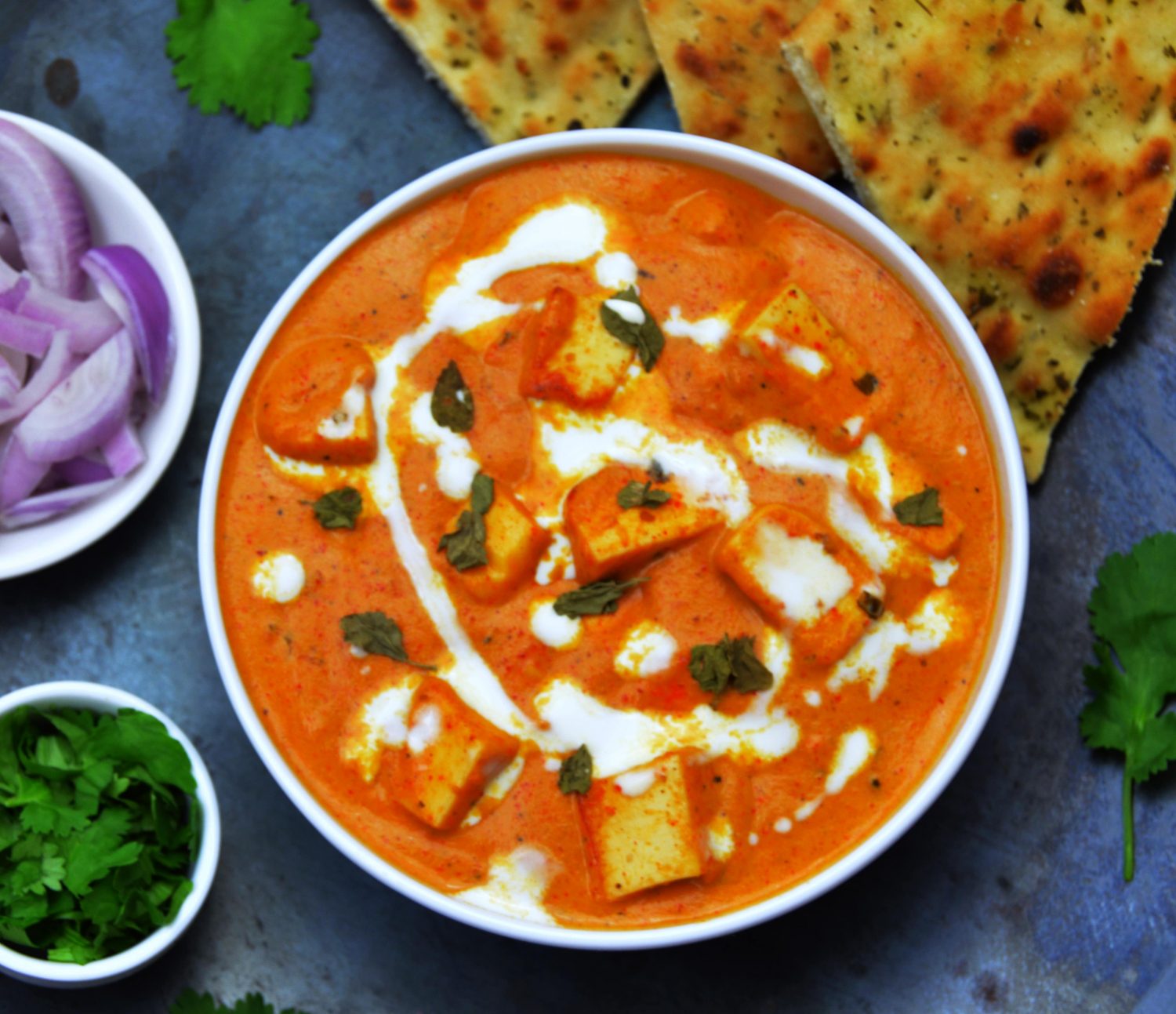Paneer Makhani, a dish that effortlessly marries the richness of Indian spices with the delicate texture of paneer, is a culinary masterpiece from the heart of Punjab. This dish, also known as Butter Paneer, has its roots deeply embedded in the rich tapestry of Indian history, where it was first prepared in the kitchens of the Mughal emperors. The Mughals, known for their love for lavish and aromatic dishes, introduced this delightful recipe, blending the creamy texture of paneer with a buttery, tomato-based gravy, enriched with spices. This concoction of flavors not only tantalizes the taste buds but also brings a piece of Indian history to your plate.

Ingredients:
- Paneer: 500 grams, cubed
- Tomatoes: 4 large, pureed
- Onion: 1 large, finely chopped
- Garlic: 4 cloves, minced
- Ginger: 1-inch piece, grated
- Green Chilies: 2, slit
- Butter: 4 tablespoons
- Cream: 1/2 cup
- Kasuri Methi (Dried Fenugreek Leaves): 1 teaspoon, crushed
- Spices:
- Cumin Seeds: 1 teaspoon
- Turmeric Powder: 1/2 teaspoon
- Red Chili Powder: 1 teaspoon
- Coriander Powder: 1 teaspoon
- Garam Masala: 1/2 teaspoon
- Sugar: 1 teaspoon (optional)
- Salt: to taste
- Fresh Coriander: for garnish
- Water: as needed
Procedure:
- Preparation of Gravy:
- Heat 2 tablespoons of butter in a pan. Add cumin seeds, onions, garlic, ginger, and green chilies. Sauté until onions turn golden.
- Add tomato puree, turmeric, red chili, and coriander powder. Cook until the oil separates.
- Let it cool and blend into a smooth paste. Strain for a silkier gravy.
- Cooking the Dish:
- In the same pan, heat the remaining butter. Add the prepared gravy and bring to a boil.
- Add paneer cubes, salt, sugar, and water (if required) for consistency. Simmer for 10 minutes.
- Stir in cream, garam masala, and crushed Kasuri Methi.
- Cook for another 2-3 minutes.
- Garnishing:
- Garnish with fresh coriander and a swirl of cream.
- Serving:
- Serve hot with naan or rice.
Tips and Tricks:
- Paneer: Always use fresh paneer for the best taste and texture.
- Cream: For a healthier option, use low-fat cream or yogurt.
- Spices: Adjust the spice levels according to your preference.
- Leftovers: Paneer Makhani tastes even better the next day as the flavors meld together.
Pairing Suggestions:
Paneer Makhani pairs wonderfully with naan, roti, jeera rice, or even pulao. Complement it with a side of cucumber raita or a light salad for a complete meal.
Healthier Benefits:
Paneer Makhani, with its luscious gravy and soft paneer cubes, is a testament to the art of balance in Indian cuisine. This balance extends beyond flavors to the nutritional value as well. Paneer, the central ingredient of this dish, is a good source of protein and calcium, making it a healthy choice for vegetarians. It’s interesting to note how paneer, a staple in Indian households, contributes to a balanced diet. For a deeper understanding of paneer’s nutritional profile and its benefits in a vegetarian diet, readers can refer to the detailed information provided by Tarladalal.
Story Behind Paneer Makhani:
The history of Paneer Makhani is as rich as its taste. Originating from the Mughal era, this dish was a favorite among the royals. The use of expensive ingredients like butter, cream, and exotic spices made it a luxury. Today, it’s a beloved dish across the globe, symbolizing Indian cuisine’s rich heritage and diversity.
Similar Dishes:
Alongside the delectable Paneer Makhani, another equally tantalizing dish that shares a similar richness and depth of flavor is Paneer Butter Masala. While both dishes boast a creamy, tomato-based gravy and the wholesome goodness of paneer, there are subtle differences in their preparation and spice profiles that make each unique. If you’re intrigued by the exquisite flavors of Indian cuisine, I highly recommend exploring the recipe for Paneer Butter Masala. Its preparation involves a distinct blend of spices and a slightly different cooking method, offering another delightful culinary experience. Dive into the recipe for Paneer Butter Masala and discover another gem of Indian gastronomy that promises to enchant your taste buds.
Conclusion:
Paneer Makhani is not just a dish; it’s a celebration of Indian flavors and history. Whether you’re cooking for a special occasion or a regular meal, this dish is sure to impress. Its creamy texture, aromatic spices, and rich history make it a must-try for anyone who loves exploring different cuisines.
FAQs:
- Can I make Paneer Makhani vegan?
- Yes, by substituting paneer with tofu and using vegan butter and cream.
- How can I make my Paneer Makhani more flavorful?
- Marinate the paneer in spices before adding it to the gravy.
- Can I freeze Paneer Makhani?
- Yes, it freezes well. Thaw and reheat with a bit of cream before serving.
- Is Paneer Makhani gluten-free?
- Yes, traditionally, it is gluten-free. Ensure that all your ingredients are gluten-free.
- What makes Paneer Makhani different from Paneer Butter Masala?
- The difference lies mainly in preparing the gravy and the spice profile.
As you savor each bite of Paneer Makhani, remember, you’re not just enjoying a dish but partaking in a story that dates back centuries, a story of royal kitchens, of rich traditions, and of a culture that prides itself on its culinary heritage. Enjoy your culinary journey with Paneer Makhani!
